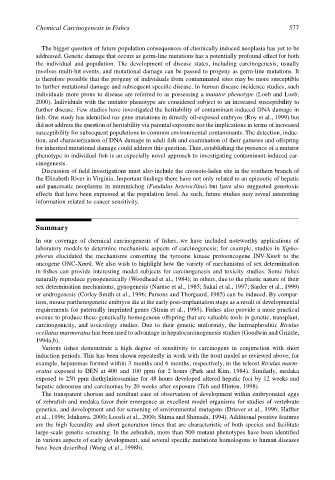Page 597 - The Toxicology of Fishes
P. 597
Chemical Carcinogenesis in Fishes 577
The bigger question of future population consequences of chemically induced neoplasia has yet to be
addressed. Genetic damage that occurs as germ-line mutations has a potentially profound effect for both
the individual and population. The development of disease states, including carcinogenesis, usually
involves multi-hit events, and mutational damage can be passed to progeny as germ-line mutations. It
is therefore possible that the progeny of individuals from contaminated sites may be more susceptible
to further mutational damage and subsequent specific disease. In human disease incidence studies, such
individuals more prone to disease are referred to as possessing a mutator phenotype (Loeb and Loeb,
2000). Individuals with the mutator phenotype are considered subject to an increased susceptibility to
further disease. Few studies have investigated the heritability of contaminant-induced DNA damage in
fish. One study has identified ras gene mutations in directly oil-exposed embryos (Roy et al., 1999) but
did not address the question of heritability via parental exposure nor the implications in terms of increased
susceptibility for subsequent populations to common environmental contaminants. The detection, induc-
tion, and characterization of DNA damage in adult fish and examination of their gametes and offspring
for inherited mutational damage could address this question. Thus, establishing the presence of a mutator
phenotype in individual fish is an especially novel approach to investigating contaminant-induced car-
cinogenesis.
Discussion of field investigations must also include the creosote-laden site in the southern branch of
the Elizabeth River in Virginia. Important findings there have not only related to an epizootic of hepatic
and pancreatic neoplasms in mummichog (Fundulus heteroclitus) but have also suggested genotoxic
effects that have been expressed at the population level. As such, future studies may reveal interesting
information related to cancer sensitivity.
Summary
In our coverage of chemical carcinogenesis of fishes, we have included noteworthy applications of
laboratory models to determine mechanistic aspects of carcinogenesis; for example, studies in Xipho-
phorus elucidated the mechanisms converting the tyrosine kinase protooncogene INV-Xmrk to the
oncogene ONC-Xmrk. We also wish to highlight how the variety of mechanisms of sex determination
in fishes can provide interesting model subjects for carcinogenesis and toxicity studies. Some fishes
naturally reproduce gynogenetically (Woodhead et al., 1984); in others, due to the plastic nature of their
sex determination mechanisms, gynogenesis (Naruse et al., 1985; Sakai et al., 1997; Sarder et al., 1999)
or androgenesis (Corley-Smith et al., 1996; Parsons and Thorgaard, 1985) can be induced. By compar-
ison, mouse parthenogenetic embryos die at the early post-implantation stage as a result of developmental
requirements for paternally imprinted genes (Strain et al., 1995). Fishes also provide a more practical
avenue to produce these genetically homogenous offspring that are valuable tools in genetic, transplant,
carcinogenicity, and toxicology studies. Due to their genetic uniformity, the hermaphroditic Rivulus
ocellatus marmoratus has been used to advantage in hepatocarcinogenesis studies (Goodwin and Grizzle,
1994a,b).
Various fishes demonstrate a high degree of sensitivity to carcinogens in conjunction with short
induction periods. This has been shown repeatedly in work with the trout model as reviewed above; for
example, hepatomas formed within 3 months and 6 months, respectively, in the teleost Rivulus marm-
oratus exposed to DEN at 400 and 100 ppm for 2 hours (Park and Kim, 1984). Similarly, medaka
exposed to 250 ppm diethylnitrosamine for 48 hours developed altered hepatic foci by 12 weeks and
hepatic adenomas and carcinomas by 20 weeks after exposure (Teh and Hinton, 1998).
The transparent chorion and resultant ease of observation of development within embryonated eggs
of zebrafish and medaka favor their emergence as excellent model organisms for studies of vertebrate
genetics, and development and for screening of environmental mutagens (Driever et al., 1996; Haffter
et al., 1996; Ishikawa, 2000; Loosli et al., 2000; Shima and Shimada, 1994). Additional positive features
are the high fecundity and short generation times that are characteristic of both species and facilitate
large-scale genetic screening. In the zebrafish, more than 500 mutant phenotypes have been identified
in various aspects of early development, and several specific mutations homologous to human diseases
have been described (Wang et al., 1998b).

